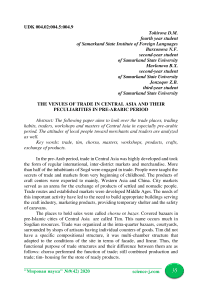The venues of trade in Central Asia and their peculiarities in pre-Arabic period
Автор: Tohirova D.M., Burxonova N.F., Mavlonova B.X., Jonzoqov Z.B.
Журнал: Мировая наука @science-j
Рубрика: Основной раздел
Статья в выпуске: 9 (42), 2020 года.
Бесплатный доступ
The following paper aims to look over the trade places, trading habits, traders, workshops and masters of Central Asia in especially pre-arabic period. The attitudes of local people toward merchants and traders are analyzed as well.
Trade, tim, chorsu, masters, workshops, products, crafts, exchange of products
Короткий адрес: https://sciup.org/140265788
IDR: 140265788 | УДК: 004.02:004.5:004.9
Текст научной статьи The venues of trade in Central Asia and their peculiarities in pre-Arabic period
In the pre-Arab period, trade in Central Asia was highly developed and took the form of regular international, inter-district markets and merchandise. More than half of the inhabitants of Sogd were engaged in trade. People were taught the secrets of trade and markets from very beginning of childhood. The products of craft centers were exported to mainly, Western Asia and China. City markets served as an arena for the exchange of products of settled and nomadic people. Trade routes and established markets were developed Middle Ages. The needs of this important activity have led to the need to build appropriate buildings serving the craft industry, marketing products, providing temporary shelter and the safety of caravans.
The places to hold sales were called chorsu or bazar . Covered bazaars in pre-Islamic cities of Central Asia are called Tim. This name occurs much in Sogdian resources. Trade was organized at the intra-quarter bazaars, courtyards, surrounded by shops of artisans having individual counters of goods. Tim did not have a specific compositional structure, it was multi-chamber structure that adapted to the conditions of the site in terms of facade, and linear. Thus, the functional purpose of trade structures and their difference between them are as follows: chorsu performed the function of trade; still combined production and trade; tim- housing for the store of ready products.
With the relatively small internal areas of these constructions, due to the narrow spans of medieval streets, the organization of their internal space created a fairly wide passage and the air reservoir, which provided coolness and twilight, convenience in the Asian blazing summers and severe winters.
Bazaars stretched along the streets, or rather, the gaps between the shops were tiny streets. These narrow streets were always filled with the noise and market crowd’s turbulence. In each row they sold particular product: ropes, gold bracelets and earrings, brushwood, silk fabrics, kitchenware, carpets, clothes were sold in individual counters. Master’s shops used to be located in walking distances to the shops or tims of their products.
Ornamental art of Central Asia reached high perfection at that times. The limitation of the ability to depict living creatures led to an increased enthusiasm for ornamentation and the attachment of accessories and, of course, its special development in the art of the East. Ornamental artists were part of almost all craft specifications corporations. In the construction business, for example, "ganchkor" - an alabaster carver - was considered a master of highest qualification. He was obliged to know thoroughly the skill of a mason, but, besides this, he also had the technology of carving and be able to draw up an original pattern.
Undoubtedly, the work of Central Asian artisans had a wide influence on the art of many countries. In Central Asia artisans united in corporations, or integrated workshops. Officially, the city of Bukhara only had 32 corporation workshops. The artisans were respected men had high status among other layers of society. Respect for the craft was supported by a number of beliefs. It was believed that Allah sent the crafts to the people through the archangel Jebrail (Gabriel).The legend about the origin of this or that craft was recorded in “Risola” (workshop Charter).
Apprenticeship lasted a very long time - 10-15 years. The acquisition of the rank of a master was accompanied by a ceremonial rite, when a crowded feast was held, each of the crafts had their own "holy" patrons. So, the patron of the farmers was Adam, whom God commanded to cultivate the land. The protector of the carpenters was Nuh (Noah), the first to pick up an ax and build a ship. Sheikh Bahauddin Naqshbandi, extremely revered in Bukhara, was the patron of many crafts, especially those related to the application of patterns. Khoja Bahauddin himself was once a weaver and made colored silk fabric with gold and silver threads.
Even 100 years ago, according to Professor A. Semenov, in bazaars you could buy everything from spectacular Maltese shawls, woven gold of Indian muslin, Iranian bronze bowls and the finest, crusader swords. In the summertime, at five in the morning, huge bazaars started to function, and the city gates were already open. The flood of people flooded all the streets, the main source of carriage was arba (primitive type of trolleys or carriages) in bazaars. When an arba with its huge wheels showed up everyone quickly rushed into narrow alleys,

pressed against the walls, jumped onto the shelves of shops and tried to get rid of unexpected bump as soon as possible.
The punishment system of the crimes happened in bazaars were extremely cruel: a hand was cut off for theft, if repeated, executed.
Large city baths were built among the bazaars and near mosques-djuma. (Friday mosques) There were also small intra-quarter cities in the Central Asian cities. The construction of public baths began in Central Asia not earlier than the 8th century, i.e. after the Arab conquest. Later they were built very intensively, and they were very popular. The therapeutic and hygienic properties of the bath were of great importance.
As there was an international sale, money changers were sitting here in bazaars, often Indians. To the XI century commodity-money relations acquired the character of a credit-bill system, which led to the creation of specialized financial offices of money changers, part of the bazaar complexes. (ancient counterparts of today’s stock market, banks, changing stands)
Among the bazaars there were mosques used for obligatory day prayers of those whose workplaces were nearby. Often they were built by communities of craft workshops.
As a conclusion, the early view of the bazaars in Central Asia was complex and well-developed till the occupation of Arabic armed forces. Different kind of masters used to export their goods to the various countries and at the same time foreign trader cаme and purchase the local manufacturer’s commodity.
Список литературы The venues of trade in Central Asia and their peculiarities in pre-Arabic period
- История Узбекистана. (С древнейших времен до наших дней). Под ред. И.М.Муминова., Т., "Фан", 1974 г.
- Гафуров Б.Г.- "Таджики", т.1, т.2. Душанбе, "Ирфон", 1989 г.
- История Самарканда. Т.1, т.2.
- Всеобщая история архитектуры. Т.8
- "Ислам на территории бывшей Российской империи". Энциклопедический словарь, вып.1,2,3,4. М., 1997 - 2003 гг.


